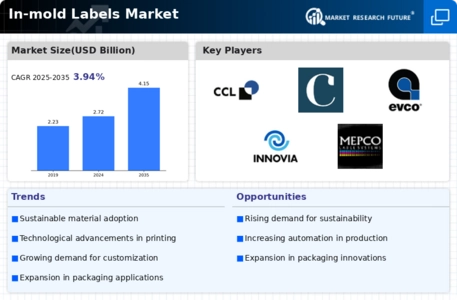Top Industry Leaders in the In mold Labels Market

In mold Labels Market
Forget stickers that peel and tags that fray, the in-mold label market offers a seamless union of branding and product. These integrated beauties become one with the container, whispering brand stories with an alluring permanence. The global in-mold label market is a battlefield where established titans and nimble innovators clash for dominance. Let's peel back the layers and explore the strategies fueling this growth, the factors influencing market share, and the recent advancements rewriting the narrative of in-mold labeling.
Strategies Embedding Success:
-
Sustainability Focus: Environmental consciousness is no longer optional. Companies like Berry Global and Avery Dennison are pioneering bio-based in-mold label materials and closed-loop recycling initiatives, minimizing waste and aligning with stricter regulations. -
Technological Advancements and Automation: Innovation is the lifeblood of this market. Companies like CCL Label are embracing advanced robotics, precision molding techniques, and laser decoration technologies, ensuring intricate designs, enhanced performance, and streamlined production processes. -
Premiumization and Brand Differentiation: In-mold labels offer unparalleled elegance and durability. Companies like Müllhaupt are catering to luxury brands with textured finishes, metallic effects, and holographic elements, creating premium experiences and strengthening brand identity. -
Functionality and Performance: Beyond aesthetics, labels must withstand harsh environments and maintain clarity. Companies exceeding expectations in heat resistance, chemical compatibility, and scratchproof surfaces attract a wider customer base. -
Cost-Effectiveness and Scalability: While innovation is crucial, affordability remains paramount. Companies like Huhtamaki are optimizing production processes and offering scalable solutions for high-volume needs, making in-mold labels accessible to a wider range of products.
Factors Forging the Market Share:
-
Performance and Aesthetics: Labels must adhere seamlessly, resist wear and tear, and offer vibrant, long-lasting graphics. Companies exceeding these expectations gain an edge in a competitive market. -
Sustainability and Environmental Impact: Stringent regulations and consumer preferences are pushing towards eco-friendly options. Companies offering bio-based materials, recyclability, and reduced waste generation gain access to valuable markets. -
Application Diversity and Market Potential: From food and beverage to automotive and medical devices, the potential applications are vast. Companies targeting diverse industries with customized solutions gain a competitive advantage. -
Technological Advancements and Automation: Faster production speeds, lower costs, and enhanced precision are key drivers. Companies embracing these advancements to streamline production processes gain a significant edge. -
Regional Market Dynamics: Demand for in-mold labels varies across regions. Developed economies with mature markets face saturation, while developing economies with rapidly growing consumer bases offer significant growth potential.
Key Companies in the In-mold Labels market include
CCL Industries Inc. (Canada)
Constantia Flexibles Group GmbH (Austria)
Huhtamaki Group (Finland)
Coveris Holdings S.A. (Luxembourg)
Cenveo Inc. (U.S.)
Fuji Seal International Inc. (Japan)
Multicolor Corporation (U.S.)
EVCO Plastics (U.S.)
Innovia Films Ltd. (U.K)
Mepco Label Systems (U.S.)
Avery Dennison Corporation (U.S.)
Century Label Inc. (U.S.)
Allen Plastic (Taiwan)
Recent Developments:
November 2020: Innovia Films' extrusion facility in Plock, Poland will receive a new capacity expansion, according to plans released by CCL Industries Inc. in November 2020. To create the EcoFloat shrink sleeve material, a new six-meter multi-layer co-extrusion line would be erected.
December 2020: Huhtamaki, a global supplier of environmentally friendly packaging options for customers, declared that it is expanding in Russia. The company is constructing a new fiber packaging manufacturing factory at its present site in Alabuga, Tatarstan, to meet the rapidly growing retail and egg packaging industries in Eastern & Central portions of Russia.

